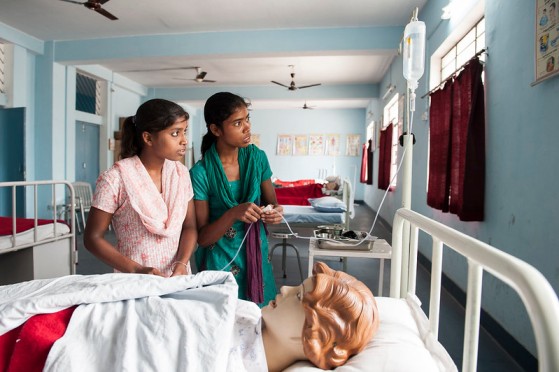India’s evolving Technical and Vocational Education and Training ecosystem (TVET) faced many challenges during the COVID-19 pandemic. Because of the national lockdown, organisations had to remain shut for 7-8 months, until September 2020. This ecosystem is made up of a range of players, including vocational education providers such as schools and higher education institutions; short-term skill development programmes supported by corporate philanthropy and National Skill Development Corporation (NSDC); public and private Industrial Training Institutes (ITI), among many others. All of these have faced an uphill task in reaching their customers, ensuring quality delivery of training, and connecting trained youth with jobs. And there have also been many lessons along the way, with different entities experimenting and adapting to the constraints posed by the pandemic.
How the pandemic impacted the skill development ecosystem
Delivery of training went online, widening the digital divide
Most skill development programmes in the country follow a classroom-led delivery model. Because of this, many faced huge infrastructure and human resource-related challenges while moving their operating models online overnight. On the one hand, participants from low-income families didn’t have access to digital infrastructure. On the other, trainers were not equipped enough to deliver virtual training, particularly while doing so from home.
The pandemic has widened the digital divide between these students, and those who have access to resources.
Though internet accessibility has increased from 27 percent to 50 percent in the past five years in India, a majority of the youth who attend skill development programmes have very limited access to smartphones and data connectivity. At Dr. Reddy’s Foundation (DRF), our skilling programmes are primarily designed for unemployed youth from low-income families, with schooling until the 10th or 12th grade. We have found that prior to the national lockdown being announced last year, 25-30 percent of our students did not own smartphones. The pandemic has widened the digital divide between these students, and those who have access to resources. Reaching them through any kind of online programme was difficult.
Few jobs, and the challenges of commuting
Job placements—a key indicator of success for all short-term training programmes—were adversely impacted when the lockdown began to be eased across the country. This was mainly due to a few things. First, there was a negative impact on the demand-supply chain, which meant there were few job openings. Sectors such as retail, hospitality, and tourism, for instance, were severely affected and had fewer job openings compared to healthcare, banking and financial services, information technology-enabled services, e-commerce, and logistics. Second, the fear of getting infected with COVID-19 forced some students and their parents to defer placements. Third, a lack of transport facilities, especially public transport, which is the preferred mode for a majority of Indians, made commuting to workplaces difficult for even those students who had received a job offer.
When cities started opening up, the local transportation cost (such as shared auto fare) tripled, creating further difficulties for students, especially in entry-level jobs which pay between INR 10,000-15,000. In our programmes, many youth who were in dire need of employment, preferred to join hyperlocal jobs, rather than travelling long distances in the absence of affordable transportation.

Funding ran dry
The funding sources for all government-sponsored programmes were largely unavailable during September-October 2020, when the lockdown was extended. This created a lot of stress on small skill development organisations and as a result, they were forced to downsize their project staff. Many of the Corporate Social Responsibility (CSR) foundations I know of have provided a lot of flexibility to their nonprofit partners to try new approaches, including virtual delivery and extending digital infrastructure support during this time. This is so they can ensure that the impact of the lockdown on their skilling programmes is minimised.
The pandemic has also created an opportunity for CSR and private foundations, for industry, and for employers to play a bigger role in creating a skilled workforce for the country.
As we are still in the midst of the pandemic, it seems that re-building the government funding pipeline may take some more time. The phase one launch of Pradhan Mantri Kaushal Vikas Yojana 3.0 in January 2021 is a welcome change as it will revitalise government-sponsored skilling programmes to some extent. But the pandemic has also created an opportunity for CSR and private foundations, for industry (through apprenticeship programmes), and for employers to play a bigger role in creating a skilled workforce for the country.
What’s next? Virtual, blended, or self-learning?
The COVID-19 pandemic saw a surge in self-learning apps and virtually delivered programmes. But maintaining the same quality of training with a digital delivery model is a challenge. There are logistical issues, then there are issues with the trainers’ approach to engaging students digitally, and of course the commitment of participants to learn online.
There is a huge opportunity to create quality digital training solutions for the youth, with a trainer-assisted programme that can be delivered in a local language.
Skilling programmes already face issues with the delivery of training and achieving the desired learning outcomes. Moving those same solutions online may in fact worsen learning outcomes. Additionally, we saw that during the lockdown, the impact of the training course varied based on the nature of the course that was delivered online. It is easy to delivery theoretical concepts online, but practical sessions still require classroom support. So, ‘foundational’ courses might see better outcomes than those that teach ‘technical’ skills online. Based on our virtual programme learning, we think there is a huge opportunity to create quality digital training solutions for this segment of youth, with a trainer-assisted programme that can be delivered in a local language.
What we did, and what we learnt
Agility, using digital technology more, diversifying our funding portfolio, and investing in a Training of Trainers (ToT) course, helped us survive the crisis as well as create something new.
At DRF, we were able to quickly transition to and manage all key processes of our ‘core employability skills’ training programme online. However, in case of our healthcare skilling programmes it was difficult for trainers to deliver classes online due to the ‘technical’ nature of the courses and the practical elements involved.
We changed our outreach strategy while on-boarding students for virtual classes by clearly explaining to them how a virtual class will be delivered, through videos. We also encouraged students and their parents to arrange for smartphones at least on a temporary basis. We made training available at a discounted fee, which enabled them to buy required data packs to avail of the virtual training.
Investing in a ToT course was very helpful. We trained our trainers to deliver virtual training effectively; we developed short videos on core modules in vernacular languages; we delivered training virtually through Zoom in the first half of the day, and utilised the second half to keep students engaged through WhatsApp. We also used our learning management system to administer assessments and share videos of core modules that students used for self-learning. Additionally, we held online meetings with parents and conducted extra sessions every Friday, which also contributed to achieving good learning outcomes.
On the funding side, having a diversified funding portfolio helped us to survive. Our long-term CSR partners supported us to manage our ‘core employability skills’ programme online, however, our healthcare skilling programme, which is supported by the government, was completely shut until the end of September.
In a recent study we conducted with the participants who were attending our virtually-delivered training, we found that 40 percent were comfortable attending the programme online (despite being given the option of in-person training). This insight helped us design a digital delivery model, which has now been tested at scale with more than 10,000 participants. We have been able to do this without deprioritising our classroom-led model, which is still very relevant for a sizeable portion of the youth we work with.
Disclaimer: Dr. Reddy’s Foundation supports IDR for research and dissemination of underserved themes in the social sector.
—





